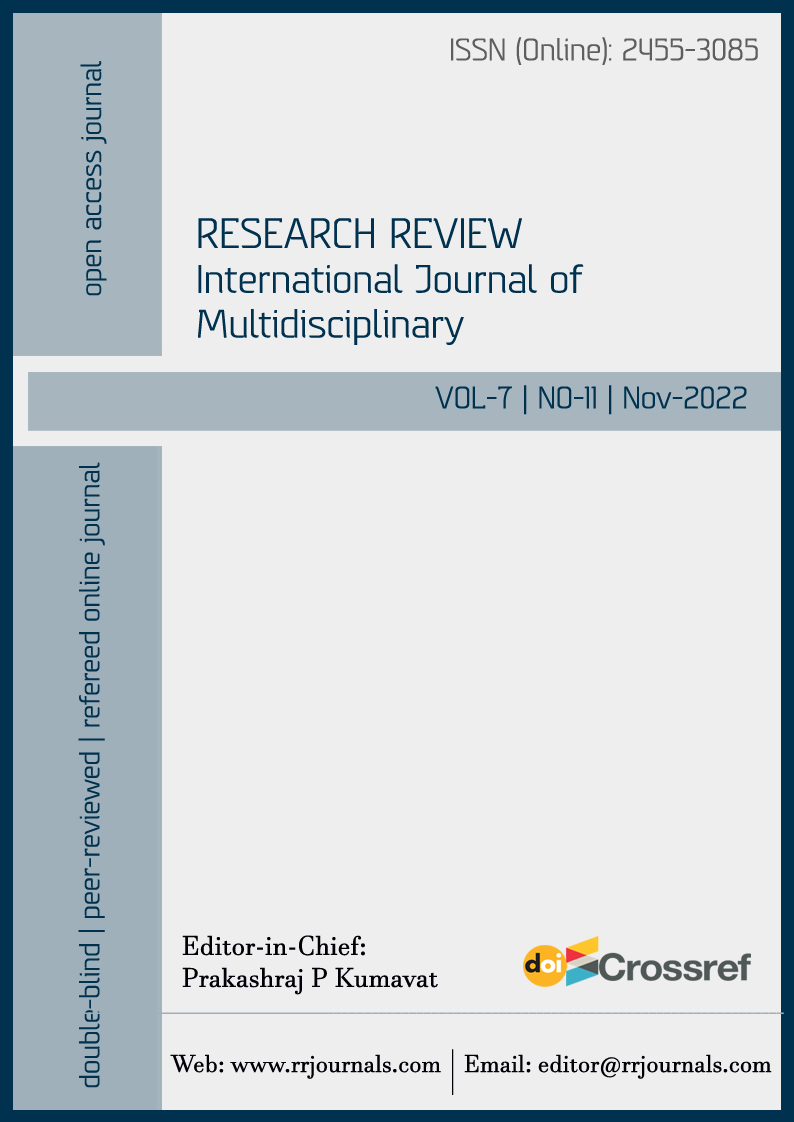Growth and Spatial Pattern of Social Well Being: Medical and Educational Facilities in Dharwad District, Karnataka
DOI:
https://doi.org/10.31305/rrijm.2022.v07.i11.021Keywords:
Primary Health center (PHC), Health workforce, Health institutions, Educational institutions, Geographical Accessibility, Healthcare UtilizationAbstract
This research paper investigates the complex relationship between social well-being and the distribution of medical and educational facilities in Dharwad District, Karnataka. The study formulates and confirms hypotheses to achieve its objectives, focusing on the impact of primary healthcare availability on population and settlement size, the influence of geographical accessibility on facility utilization, and the role of health workforce in meeting the actual medical requirements. The analysis relies predominantly on secondary data from sources such as the district Census Handbook, District at a Glance, Dharwad District Health Office, DDPI, and village and town directories. The study utilizes the nearest neighbor analysis to discern the spatial patterns of education and medical facilities, with a specific emphasis on government services. Findings from this research contribute valuable insights into the correlation between social well-being and the provision of healthcare and education. By confirming hypotheses related to healthcare availability, accessibility, and the role of health workforce, the study sheds light on the dynamics influencing the growth and spatial distribution of social well-being indicators in Dharwad District.
References
Bangheri N., Benwell G.L. and Holt A. (2005): Measuring Spatial Accessibility to Primary Health Care. Presented atSIRC-17th Annual Colloquium of Information Research Centre, University of Otago, Dunedin, Newzeland.
Chatti and Shahu R. (2011) : Health Care Scenario in Darjeeling Hills-With Spcial Reference to Kalimpong Block-II.National Geographical Journal of India, Vol-57,pp-75-80.
Eyles J. Wood K.J.(1983) : The social Geography of Medicine and Health, Croom Helm, London.
Hyma and Ramesh A. (1991) : System of Health care; Profile of users in Madras, Transactions, I,I,G Vol-7, pp-17-39.
Izahar Nilofer (2015) : Geography and Health: A Study in Medical Geography, APH publishing Corporation, New Delhi.
Jayashree. De and Kanchan (1991) :
Joseph A. and Phillips D.(1984) : Accessibility and Utilization : Geographical Perspectives on Health Care Delivery. (New York :Harper and Row London., 1984).
Krisha Kumari, Ravindra R. and Nagaveni (2006): A study of Health Care Delivery Systems in Kurnool District, Andhra Pradesh. The Deccan Geographers Vol.44 No.2 pp-13-26.
Made S. M. and Erickson J. R. (ed2005): Medical Geography, Rawat Publishers, Jaipur.
Morrill, Errickson and Rees (1970): Factors influencing Distance traveled to hospital, Economic Geography. Vol.46, pp-161-170.
Phillips, D. K. (1981): Contemporary issues in the Geography of Health Care, Norwich,Geo Books.
Rolee Kanchan and Tathagata Ghosh (2012): Spatial analysis of Accessibility and Utilization of Primary Health Centres using GIS: A case study of Nadia District, West Bengal, India. Regional Symbiosis.Vol-20, pp-7-20.
Shannon and Spurlock (1976): Urban Ecological containers, Environmental risk cells and the use of medical services, Economic geography. Vol.52, No-2, pp-171-180.
Sinha S. C. (2012): Medical Geography, Rajat Publication, New Delhi.
Statham J., Chase E. (2010): Childhood wellbeing: A brief overview, Childhood Well-Being, Research Centre, Institute of education, University of London.
Swapnali Saikia and Branali Gogoi (20415) : An Analysis of social Well-Being In Terms of Education and Health Services in Jorhat District, Assam. Geographical Review of India, Vol-77, No.1 pp-67-84.
Vasantkumaran and Jayapal P. (1984): Health facility use locational efficiency in the Madras neighborhood. The L. G. Journal. Vol. 59, No-1, pp- 124-129.
World Health Organization (1978): Alma Ata: Primary Health Care: report of thr international conference on primary health care , Alma Ata, USSR,. Health for All, Series No.11.
Yamauchi Chowdhury et. Al.(2007) : Spatial coordination in Public Good Allocation: Non Parametric Evidence from Decentralized Indonesia, International Food Policy Research Institute.
Downloads
Published
How to Cite
Issue
Section
License

This work is licensed under a Creative Commons Attribution-NonCommercial 4.0 International License.
This is an open access article under the CC BY-NC-ND license Creative Commons Attribution-Noncommercial 4.0 International (CC BY-NC 4.0).



